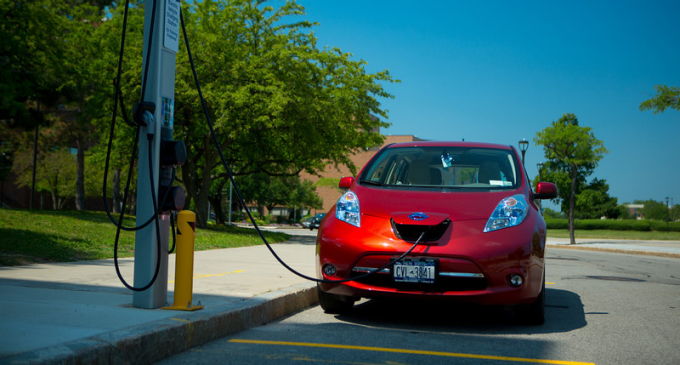Sustainable Transportation Systems

Researches transportation system sustainability including smart growth, alternative vehicle and fuel technologies, intelligent transportation systems, pricing incentives, green logistics, and alternative transportation modes.
This research area will link the Stephen Still Institute to UB’s Energy Diversification Initiative through work on transportation energy issues (e.g. plug-in hybrid vehicles). The area is also extremely well aligned with one of the Power of SUNY2020 “Six Big Ideas,” namely “Energy-Smart New York.”
Projects
An Evaluation of Likely Environmental Benefits of Lowest Fuel Consumption Route Guidance in the Buffalo-Niagara Metropolitan Area

Modeling the impact of green routing
With worldwide concerns about energy shortage and global warming, finding methods to cut down on energy consumption and emissions from surface transportation has become of paramount importance. Different strategies are currently being studied for their potential to mitigate the negative impacts of the surface transportation sector on the environment. The focus of this study is on an Intelligent Transportation Systems (ITS) strategy which involves providing route guidance to travelers with the objective of minimizing emissions or fuel consumption, as opposed to the traditional objective of minimizing travel times. Specifically, this study conducts a realistic assessment, using a real-world case study, of the likely environmental benefits of environmentally-based route guidance.
Several features distinguish this study from previous reported research. First, the research utilizes a realistic case study of a medium-sized metropolitan area in the United States with a population of about 1.2 million. Second, the research applies the latest state-of-the-art models on both the transportation as well as the environmental modeling side, through the development of an integrated model combing the Transportation Analysis and Simulation System (TRANSIMS) model and the Multi-Scale MOtor Vehicle Emissions Simulator model (MOVES). Third, the integrated model is used to approximate “Green User Equilibrium”, and to investigate the impact of market penetration on the likely environmental benefits of green routing.
Finally, the findings suggest that reductions in emissions of sizeable magnitude are possible with green routing, but the savings in fuel consumption appears to be more modest.
Participants
Funding Sources
- Federal Highway Administration
- ITS Joint Program Office
- The AERIS Program
Smart Land Use Design for Reducing Vehicle-Miles Traveled
In this project, recently awarded by New York State Energy Research and Development Authority (NYSERDA), Dr. Sadek and Dr. Wang will first identify the most appropriate methods that would allow for better reflecting the benefits of smart growth in travel demand forecasting practice. Using a case study from the Greater Buffalo/Niagara metropolitan area, the project will then demonstrate how these methods can be best implemented. Finally, the project will develop a decision support system (DSS) that would capitalize on the increased sensitivity of demand forecasting models in order to optimally design the land use so as to reduce VMT. With these tools, planners would be able to present a convincing case for smart growth, which should encourage more jurisdictions to adopt and implement such concepts.
Participants
Funding Sources
- New York State Energy Research and Development Authority (NYSERDA)
- New York State Department of Transportation (NYSDOT)
Smart Driving through Crowdsourcing
Nearly 42% of newly-sold vehicles in the U.S. have a telematics unit installed capable of collecting breadcrumb trails. This number is expected to reach 80% in the U.S. at the end of 2018. These trails provide data that could help identify potential traffic hazards in real time, and help identify driving behavior in response to traffic signs/signals and real time traffic conditions, as well as advise drivers adaptively on safe driving, fuel efficient driving, routes with least time, and routes with least mental load. A crowdsourcing approach will provide new insights in improving our road transportation.
Participants
Evaluating the Likely Environmental Benefits of Green Routing and Intelligent Intersections
A relatively new line of research which ISTL researchers have been probing recently focuses on evaluating the likely environmental benefits of intelligent transportation systems. In a recently completed project, ISTL researchers conducted a realistic assessment, using a real-world case study, of the likely environmental benefits of an ITS strategy that involves providing dynamic Preliminary results indicate that green routing could result in significant reductions in emissions, but that this naturally comes at the expense of an increased travel time. For one scenario considered assuming a traffic stream of only passenger cars, green routing resulted in an almost 13% reduction in Carbon Monoxide (CO) emissions, and a corresponding 8% increase in travel time. The results also indicate that tangible emissions reductions are achievable at low to medium market penetration levels for green routing application, especially when the strategy is applied in a way that intelligently targets travelers with the largest likely emissions savings.
Participants
Funding Sources
- USDOT
- ITS Joint Program Office


